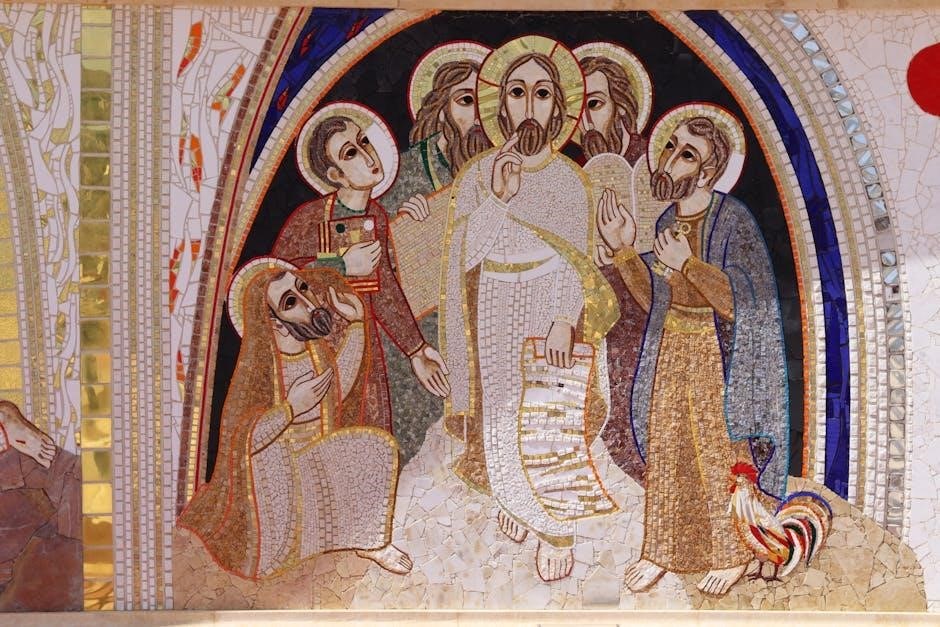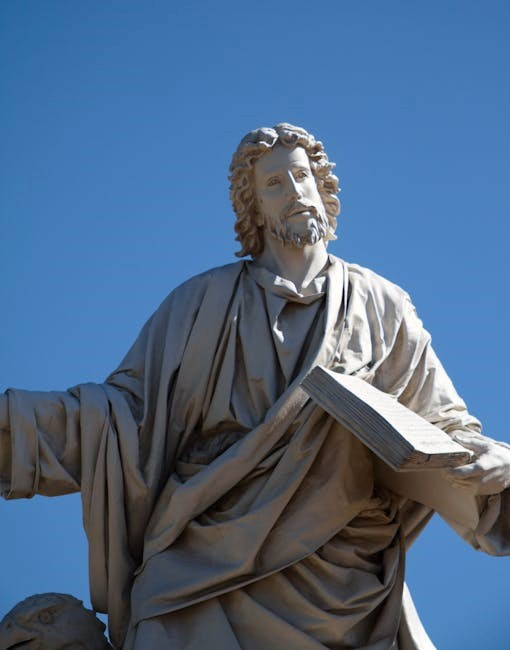how the disciples of jesus died pdf

how the disciples of jesus died pdf
The deaths of Jesus’ disciples, as recorded in Christian tradition, reveal their unwavering commitment to spreading His teachings, often ending in martyrdom․ Their sacrifices laid the foundation for the spread of Christianity, with most meeting violent ends, except for John, who died peacefully of old age․
Overview of the Deaths of Jesus’ Disciples
The deaths of Jesus’ disciples were marked by extreme brutality and sacrifice, reflecting their unwavering dedication to spreading His teachings․ Most of the Twelve Apostles met violent ends, with methods ranging from crucifixion and stoning to beheading and beating․ Notably, John was the only disciple to die of natural causes, passing away in exile after a life of persecution․ The accounts of their deaths, though varying in detail, consistently emphasize their courage and devotion to their faith․ These martyrdoms became a cornerstone of Christian tradition, inspiring believers for centuries․ The sacrifices of the disciples underscored the transformative power of Jesus’ message, even in the face of immense adversity․ Their deaths not only solidified their legacy but also played a crucial role in the spread of Christianity across the ancient world․

The Martyrdom of the Apostles
The apostles endured brutal martydoms, with most suffering violent deaths for their faith․ Their sacrifices, documented in tradition, highlight unparalleled devotion to Christ’s teachings, shaping Christianity’s legacy․
Saint James, Son of Zebedee
Saint James, the son of Zebedee, was one of Jesus’ original disciples and the brother of John the Evangelist․ He is often referred to as James the Greater to distinguish him from another apostle named James, the son of Alphaeus․ According to Christian tradition, James was martyred during the reign of Herod Agrippa I, who sought to persecute early Christians․ In approximately 44 AD, Herod had James beheaded in Jerusalem, making him the first apostle to suffer martyrdom․ This event is documented in the New Testament in Acts 12:1-2, highlighting the brutal nature of his death; James’ martyrdom serves as a testament to the early Christian community’s resilience and faith in the face of persecution․ His legacy endures as a symbol of unwavering devotion to Christ’s teachings․
Saint Peter
Saint Peter, one of Jesus’ most prominent disciples, is widely recognized for his leadership in the early Christian church․ According to tradition, Peter was martyred in Rome during the reign of Emperor Nero in the mid-1st century AD․ He was crucified, but at his request, he was nailed to the cross upside down, believing himself unworthy to die in the same manner as Jesus․ This unique method of execution became a symbol of his humility and devotion․ Peter’s death marked the end of a life dedicated to spreading Jesus’ teachings, and his legacy as a foundational figure in Christianity has endured for centuries․ His martyrdom is often seen as a testament to his unyielding faith, even in the face of extreme persecution․

Saint John
Saint John, often referred to as “the beloved disciple,” is unique among the apostles as the only one who did not die a martyr’s death․ He faced significant persecution, including exile to the island of Patmos under Emperor Domitian, where he is believed to have written the Book of Revelation․ Despite these hardships, John lived into old age and died peacefully in Ephesus, a city in modern-day Turkey․ His life exemplifies endurance and devotion, as he continued to serve as a leader in the early Christian church until his natural death․ John’s legacy is profound, not only as a witness to Jesus’ life but also as a theologian and writer whose works remain central to Christian theology․
Saint Andrew
Saint Andrew, one of Jesus’ earliest disciples and the brother of Saint Peter, is traditionally believed to have been crucified on an X-shaped cross in Patras, Greece․ According to Christian tradition, Andrew preached the Gospel in various regions, including Achaia and Epirus, before his martyrdom․ He was arrested and sentenced to death for his unwavering faith․ Legend states that Andrew requested to be crucified on a cross different from Jesus’, deeming himself unworthy to die in the same manner․ During his crucifixion, Andrew reportedly preached to onlookers, sharing the message of Christ even in his final moments․ His death by crucifixion, though violent, is seen as a testament to his devotion and bravery in spreading the teachings of Jesus․ Andrew’s missionary journeys and ultimate sacrifice have made him a revered figure in Christian tradition․
Saint Thomas
Saint Thomas, often referred to as “Doubting Thomas” due to his skepticism of Jesus’ resurrection, is traditionally believed to have met a violent end in India․ According to Christian tradition, Thomas traveled extensively as a missionary, preaching the Gospel in regions such as Mesopotamia, Persia, and Ethiopia․ His missionary work eventually led him to India, where he was martyred․ Thomas was reportedly pierced with a spear by local priests who opposed his teachings․ This method of execution is often cited in historical and religious accounts․ Thomas’s death is seen as a testament to his unwavering dedication to spreading Christianity, even in the face of danger․ His legacy endures as one of the apostles who sacrificed his life for the faith, leaving a profound impact on early Christian communities․
Saint Philip
Saint Philip, one of Jesus’ original disciples, is believed to have met a tragic end while spreading the Gospel․ According to Christian tradition, Philip preached extensively in regions such as Syria and Phrygia․ His missionary work eventually led him to face severe persecution․ Philip was captured by authorities in Phrygia and subjected to brutal treatment․ He was beaten with clubs and subsequently crucified upside down on a cross․ This manner of execution was a common method used to martyr early Christian missionaries․ Philip’s death occurred after two days of suffering on the cross, demonstrating his unwavering faith and dedication to his beliefs․ His martyrdom is remembered as a testament to the sacrifices made by the apostles in spreading Jesus’ teachings, leaving a lasting legacy in the early Christian Church․

Saint Bartholomew

Saint Bartholomew, one of Jesus’ twelve apostles, met a gruesome end while spreading the Gospel in Armenia․ According to Christian tradition, Bartholomew was martyred for his unwavering faith and missionary work․ He was captured by local authorities and subjected to extreme torture․ The most notable account of his death describes him being flayed alive, where his skin was brutally torn from his body․ After enduring this agonizing ordeal, he was crucified upside down, a method intended to prolong his suffering․ Bartholomew’s death is a stark reminder of the violent persecution faced by early Christians․ His martyrdom is celebrated in various traditions, with his feast day honoring his courage and devotion to spreading Jesus’ teachings, even in the face of such brutality․
Saint Matthew
Saint Matthew, one of Jesus’ original twelve apostles, is traditionally believed to have met a violent end while spreading the Gospel․ According to Christian tradition, Matthew traveled to Ethiopia to preach the teachings of Christ․ During his missionary work, he faced intense opposition from local leaders who resisted his message․ As a result, Matthew was martyred in Ethiopia around 60 AD․ The most widely accepted account of his death describes him being stoned and then beheaded with a halberd, a weapon with an axe-like blade․ His martyrdom is seen as a testament to his unwavering faith and dedication to sharing the message of Jesus․ Matthew’s legacy endures through his Gospel, which remains a foundational text of Christianity, highlighting the life and teachings of Jesus Christ․
Saint James, Son of Alphaeus
Saint James, the son of Alphaeus, was one of Jesus’ original twelve apostles and is often referred to as “James the Less” to distinguish him from James, the son of Zebedee․ According to Christian tradition, James played a significant role in the early church, particularly in Jerusalem, where he served as a leader․ His death occurred during a period of intense persecution, as described in accounts such as those found in the Acts of the Apostles․ James was thrown from the top of the Temple in Jerusalem and, though injured, he survived the fall․ However, his ordeal did not end there; he was subsequently beaten with a fuller’s club, a brutal weapon used in ancient times, which led to his death․ This violent end to his life, at the age of 94, underscores his unwavering dedication to his faith and his role as a martyr for Christianity․
Saint Simon the Zealot
Saint Simon the Zealot, one of Jesus’ twelve apostles, is known for his passionate devotion and his association with the Zealot movement, which sought to overthrow Roman rule in Judea․ After Jesus’ resurrection, Simon dedicated his life to spreading the Gospel, engaging in missionary work across various regions, including North Africa, Egypt, and even Britain, according to some traditions․ His death, as recorded in Christian tradition, occurred during a wave of persecution․ Simon was crucified, a common fate for many early Christian martyrs, in the city of Edessa, modern-day Turkey, around 72 AD․ His martyrdom, marked by crucifixion, symbolizes his unwavering commitment to his faith and his role as a dedicated follower of Christ․
Saint Judas Iscariot
Saint Judas Iscariot, one of Jesus’ twelve apostles, is infamously known for betraying Jesus, leading to His arrest and crucifixion․ According to the New Testament, Judas accepted thirty pieces of silver to hand Jesus over to the authorities․ After realizing the gravity of his actions, Judas returned the money and, overwhelmed by guilt, took his own life․ His death is recorded in Acts 1:18 and Matthew 27:5, where he is said to have hanged himself․ Judas’s tragic end serves as a cautionary tale about betrayal and the consequences of sin․ Despite his role in the events leading to Jesus’ death, Judas’s story remains a significant part of Christian history, illustrating the complexities of human nature and the divine plan unfolding despite human failings․
The deaths of Jesus’ disciples, marked by martyrdom and sacrifice, underscore their unwavering faith and commitment to His teachings․ Their legacy endures, shaping Christianity’s foundation․
The Legacy of the Apostles’ Deaths
The deaths of Jesus’ disciples had a profound impact on the spread of Christianity, inspiring countless believers to embrace their faith despite persecution․ Their martyrdom became a testament to their unwavering commitment to Jesus’ teachings, solidifying their roles as foundational figures in Christian history․ The apostles’ sacrifices demonstrated extraordinary courage, setting an example for early Christians and future generations․ Their legacy endures through the global spread of Christianity, as their stories of faith and resilience continue to inspire․ The manner of their deaths, often symbolic and tied to their ministries, further emphasized the depth of their devotion․ Today, their martyrdom remains a cornerstone of Christian theology, reminding believers of the transformative power of faith and sacrifice․